In our How to Paint Everything series, we take a look at different armies of the Warhammer universe, examine their history and heraldry, and look at several different methods for painting them. With the release of Engine War we’re looking at the forces of the Chaos Daemons, and this instalment is dedicated to the Prince of Pleasure, She Who Thirsts, Slaanesh.
Who are the Daemons of Slaanesh?
Slaanesh, the dark prince, or known to the Eldar as “She Who Thirsts,” Is the Chaos god of pleasure, excess, lust, pride, and decadence. Of the four Chaos Gods, Slaanesh is the youngest and least powerful, and is the only one who has very divergent backstories and lore based on whether you’re in the 40k universe or the Age of Sigmar universe.
In 40k, Slaanesh was born some time before the year 30,000, when the Eldar reached the height of their decadence as a culture. The Aeldari’s rampant debauchery finally reached a crescendo at some point and the energies, emotion, and psychic power from that action combined to birth a new chaos god. Slaanesh’s birth caused the rift in realspace known as the Eye of Terror, sucking in countless Aeldari worlds and dissipating the warp storms that had covered the galaxy and long made warp travel impossible. In the wake of Slaanesh’s birth, the stage was set for the Imperium of Man to begin reclaiming the galaxy.
In the Age of Sigmar, Slaanesh was around before in the world-that-was, and in the Great Shattering gorged itself on Aelven souls, swelling in size and power. The Dark Prince stoked the obsessions and sensations of the early inhabitants of the mortal realms, creating followers called the Hedonites of Slaanesh. However Slaanesh has been missing from the mortal realms for some time, having been captured by the Aelven gods Hysh and Ulgu. Slaanesh is trapped between realms, bound by magical energies, and forced to relinquish the Aelven souls it devoured when the world-that-was was shattered.
The Daemons of Slaanesh are twisted representations of desire and perversion, often intersexed and with lithe forms that move in beguiling ways. The daemons of Slaanesh thrive on temptation and obsession, feeding on mortals’ pride.
Where to read more
If you’re looking to read more about the depraved followers of Slaanesh and her daemons, consider the following books:
- A Song for the Lost by Robbie MacNiven is a short story that features daemons of Slaanesh.
- Call of Chaos by Rob Sanders follows a Slaaneshi warlord through an encounter with the Stormcast Eternals.
- Daemon World by Ben Counter follows the Word Bearers but takes place on a Daemon World of Slaanesh in the Eye of Terror and features a daemon princess of Slaanesh as its primary antagonist.
- Shadowsword by Guy Haley follows the Baneblade book and features Slaaneshi daemons as the primary antagonists, and while the focus is on the guardsmen in the tank crew, there’s some interesting action near the end between daemons and Black Templars.
- The Fabius Bile books Primogenitor and Clonelord also have some Slaanesh daemons, and feature the Emperor’s Children, a traitor legion that fell to worship of She Who Thirsts.
Playing Slaaneshi Armies
- In 40k, check out our guide to the armies of Slaanesh and our Chaos Daemons Start Competing Faction Guide.
- In Kill Team, check out our guide to Chaos Daemons kill teams.
- We don’t have a guide for Hedonites of Slaanesh yet for Age of Sigmar, but it’s in the works!
Painting Slaanesh Daemons
Charlie A’s Way
I’ve only ever painted this one Slaanesh model, so if you’re looking for a Slaanesh diehard fan, look elsewhere. I won’t be offended. I used the Contorted Epitome as a test model for some new Scale 75 metallics I recently purchased in addition to using it as an exercise in glazing, something I haven’t been very good at. All in all, I pretty happy with how it turned out, though it did take a while, so this method isn’t my usual “bang it out efficiently” sort of guide.
My color pallet and overall inspiration come from Vince Vinturella, who, if you’re not familiar with, is an excellent painter and teacher. He produces many helpful painting tutorial videos on YouTube and is a great painter to follow. He’s painted a lot of Slaanesh daemons, as well as, specifically, a Contorted Epitome. I didn’t have the exact colors he used but wanted a similar feel of teals and pinks/purples. I started the model with a black prime and then zenithal highlighted with white ink. This is pretty much always the first step for models that I care about and its a very helpful foundational step. For me, I don’t fully look at all the details of a model until I do this step, taking care to notice points of interest and features I want to draw attention to while zenithal highlighting.
Next, I laid down some basic skin tones, ranging from Model Color Royal Purple (shadow), to Pink Horror (midtone), up to Kislev Flesh (highlight). It’s pretty desaturated at this point, but the gist is there.
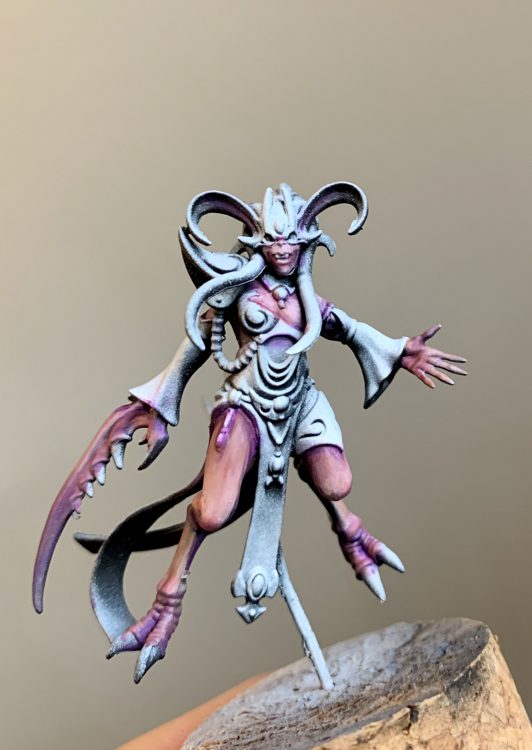
Next, I worked with Army Painter Hydra Turquoise, and this is where I started going off the rails a bit. I started mixing my own colors, which can be scary as hell because I generally feel like I don’t know what I’m doing. I added Corvus Black to the turquoise for the shadow and layered/glazed up to a very light highlight. It was around this point that I really started enjoying the model and decided to put in a lot of effort. Unfortunately for me, there were plenty of mould lines I had neglected to remove. Hindsight is a bitch.
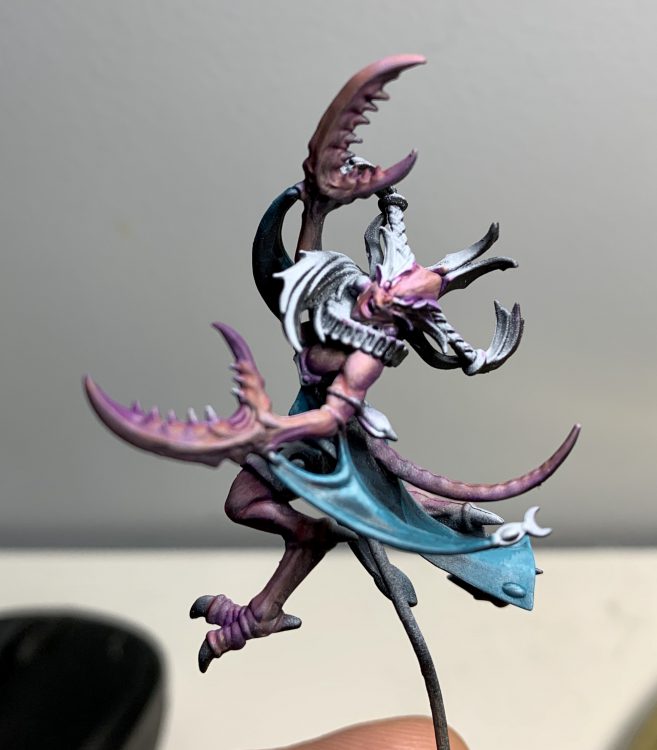
The saturation is better on the skin and some of the cloth at this stage. I just did more of the same from previous steps trying to darken the darkest areas and brighten the highlights. I also added a little red/Pink Horror on joints (knees, ankles, etc.) to create a more realistic look.
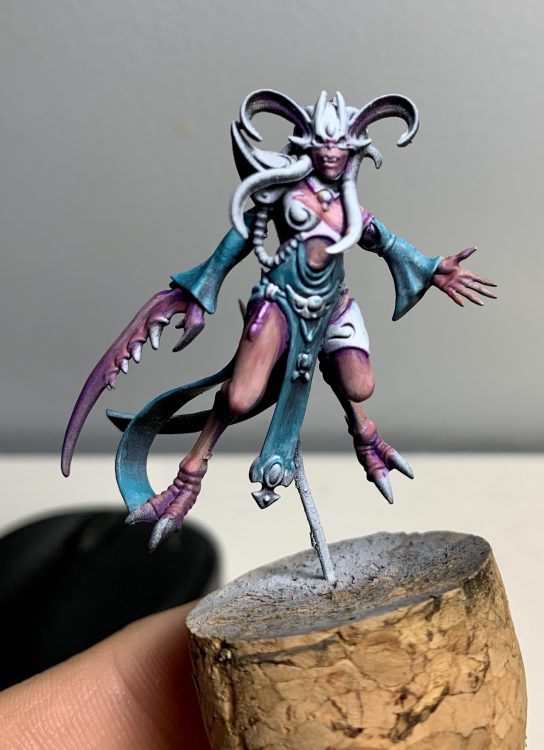
Obviously a lot has taken place between previous pictures and the one below. The gold was all done with the Scale 75 Gold Metallics and I cannot recommend them enough. They’re very easy to work with and were much better in coverage and usability than any other metallics range I’ve used (at least, that has a good gold). All of the red gems started at Corvus Black and I glazed the red down, completing the effect with a dot of white at the top.
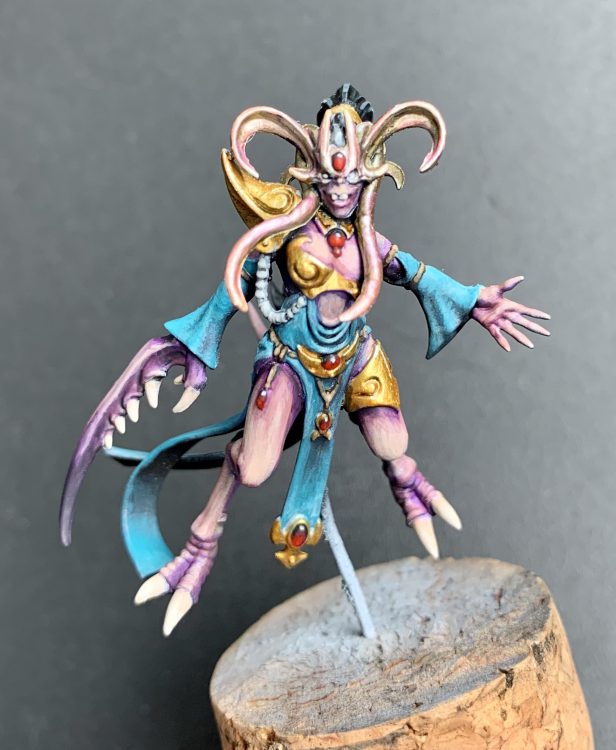
The hair is black and done with contrast Black Templar, then edge highlighted. Super simple and a solid look.
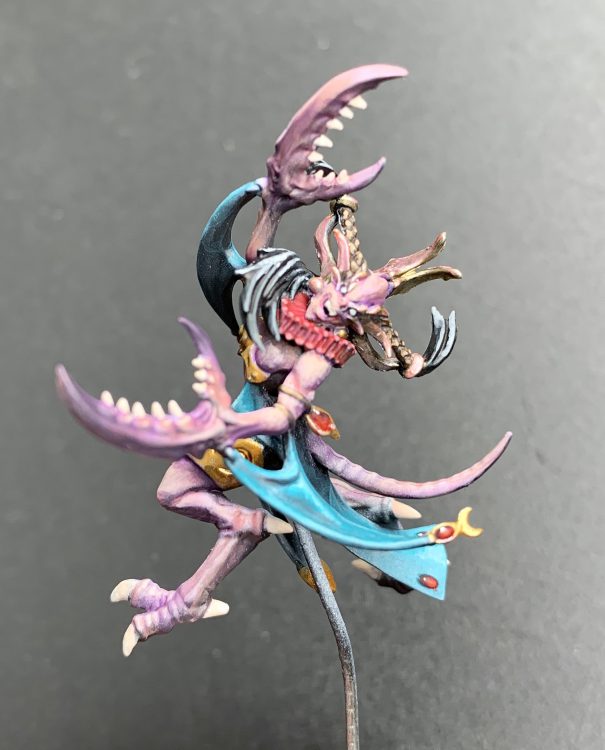
Next, it was on to the mirror. I had no real clue what I wanted to do at first, so started by glazing/blending a radius of the Royal Purple over a basecoat of Corvus Black. I liked where it was going, so used a pink to do a shorter blend as well. At this point, I was ready to push myself a bit further and wanted to try some freehand for the first time.

After googling Slaanesh art (… it was actually art, get your mind out of the gutter), I came up with some eyes and a mouth I liked. Due to the layout of the mirror and to be extra spooky, I decided to have the eye down low and the mouth up top. You can do literally anything and justify it as “Chaos”. I followed the principles for freehand from our own Free-Hand Guide and it was incredibly useful. Who knew GoonHammer made useful content??
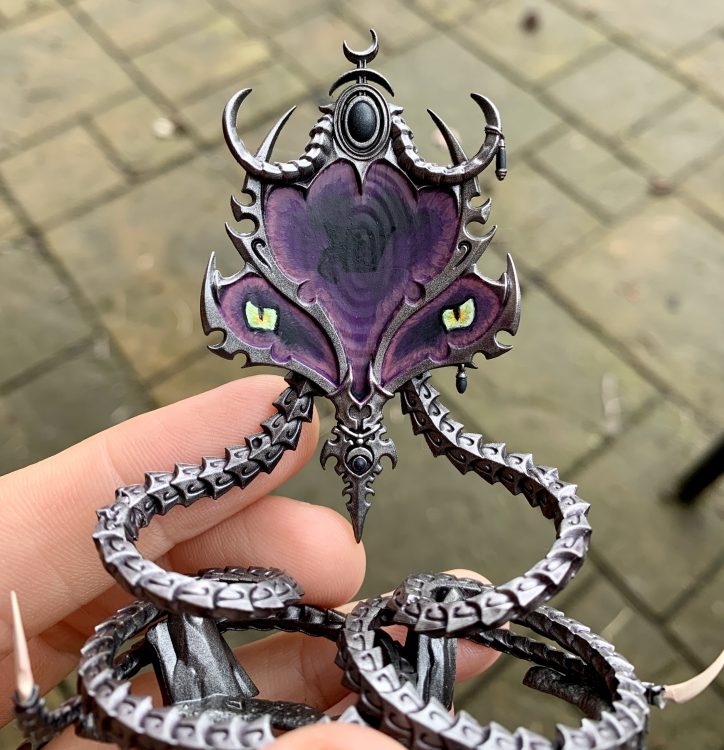
Here, above, you can see the mouth blocked out and the eyes more or less done. I tried to go for a “cat-eye” effect but didn’t necessarily pull that off. They don’t look terrible though. Below, you can see the mouth completed, which I was very happy with. Slaanesh most definitely has a tongue fetish.

And here we are! Deamonettes attached to the mirror and some mud on the base to match my army. Before someone goes pointing out that I mis-assembled part of the front left coil of the mirror, yes, I’m aware. It just goes to show that you should always take your time with assembly and clean up because you never know what level of effort you’re going to put in. Better to be safe than sorry.

Beanith’s guide to this weird lizard horse thing (Seekers of Slaanesh)
Or a guide on how to avoid painting Death Guard… Haha, I’m kidding, these HTPE series are an excellent excuse to try new techniques and paint something other than power armor. Plus it’s a solid excuse to buy more paints because that paint rack won’t fill itself.
Today I’m sitting down with a Seeker of Slaanesh, the incarnation of the Dark Prince’s free spirit, which as it turns out is a lizard horse hybrid because of reasons.
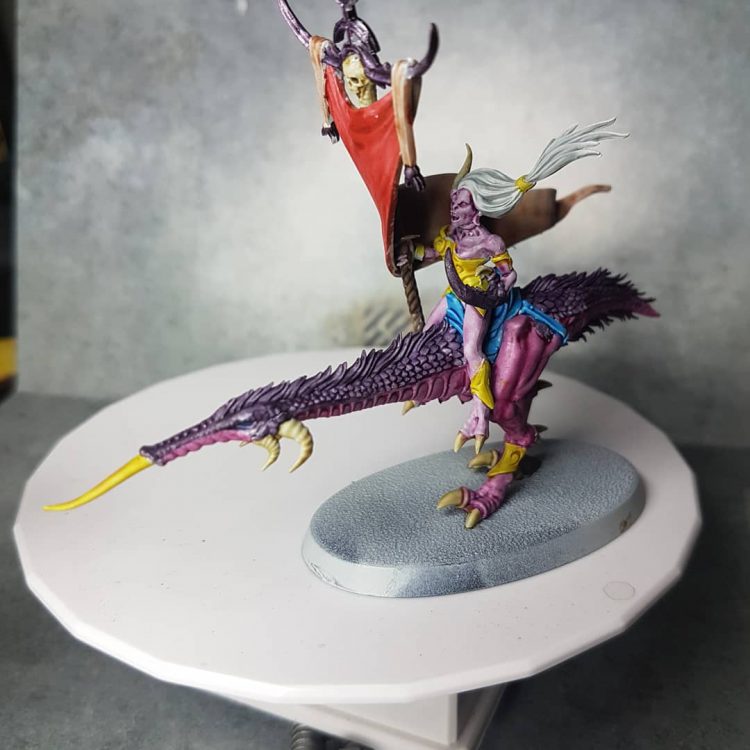
- I use the Grey Seer Spray to undercoat the model.
- Contrast Volupus Pink for the body of the mount.
- I hit the scales and the top of the banner in places with Runefang Steel so that when I paint the scales and fur with Contrast Shyish Purple there is a nice metallic sheen. I also hit the crab claw as well.
- Contrast Magos Purple for the skin tone on the Daemonette
- Contrast Talassar Blue on the saddle.
- The armor and tongue is Contrast Iyanden Yellow and the hair is Contrast Apothecary White.
- The banner I went for a flayed skin attempt with Contrast Guilliman Flesh and Contrast Blood Angel Red on each side. The plan being it should be easy to apply transfers at a later date. The banner pole is Contrast Wyldwood
- Paint all the claws and bones with Contrast Skeleton Horde

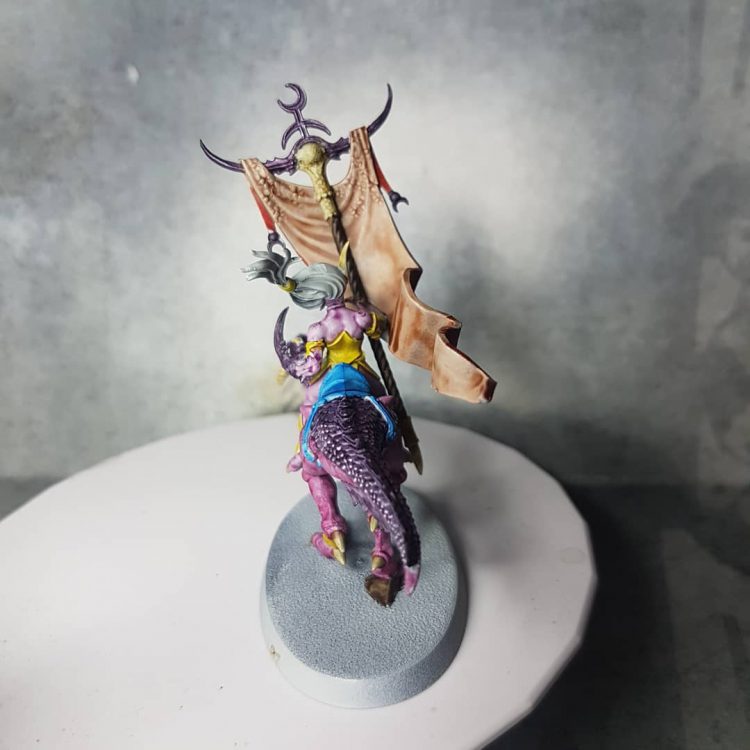
Bish bosh bash, job done son.
Or at least it would be if I didn’t have a bunch more Daemons sitting in my paint queue to knock out as thanks to my friend Amatri for lending me her stuff to paint. Hurray for Contrast paints being a fantastic match for quickly painting Daemons, I might even be done in time for 9th. Good job I know a site with a ton of tips on painting these guys.
Mentor’s way
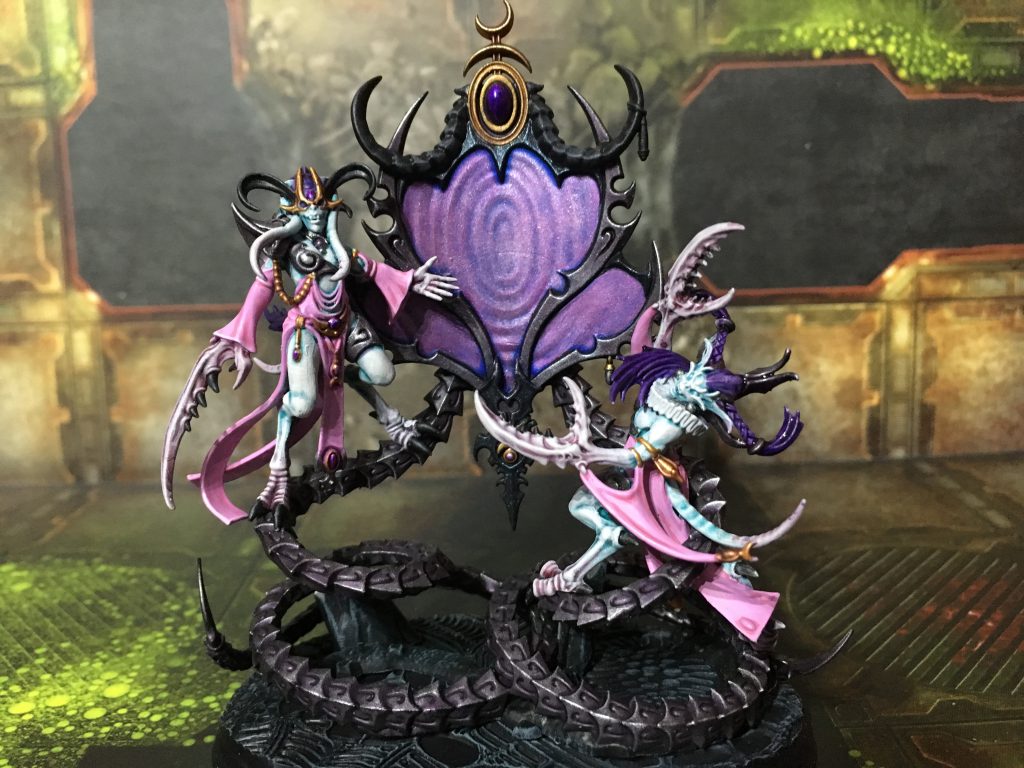
Back when Slaanesh Daemons got their update in the far-off date of Feb 2019 I was in a real pickle. I had the idea of some bright pink/blue contrasted daemonettes and pals to back up my purple/blank Noise Marines and no idea how to achieve that satisfyingly.
Then for once procrastination paid off, as what did we get later that year? Contrast paints, and with that I was sloshing away like a mad ham.
For the Contorted Epitome and Syll’esske and I made sure to part out the parts of the models that were mostly flesh and cloth and the big metal parts of both kits and primed them separately. Citadel Gray Seer for the actual Daemon part of the figures, and a glossy black (in this case, Citadel Chaos Black with an all over Citadel Nuln Oil Gloss wash) for the mirror/giant backpack thing. This is important for getting the colourshift paints we’ll be using later in the process to work correctly.
Skin:
– Wash all over with a Contrast Basilicanum Grey, super thinned down with Contrast Medium. This should resemble more of a traditional shade wash than the usual Contrast coat, our goal here to provide a nice undershade for the rest of the model.
– Wash the majority of the model’s skin with a 1:3 Contrast Aethermatic Blue/Contrast Medium mix, leaving the extremities of the various limbs (arms, legs and tail) untouched. You can vary how far down you go towards the ends to vary up a little.
– Wash the previously untouched areas with a 1:3 Contrast Volupus Pink/Contrast Medium mix. If you’re quick enough between the steps you can wet blend the two different colours together by dabbing on some clean Contrast Medium and splotching the area where they meet.
– Highlight the skin with your preferred off-white, I find either VMC Ghost Grey or Citadel Palid Wych Flesh works well. Build it up over several thin-ass layers so not to lose the unnatural tones we built up. Soft-drybrushing can work well here as well.
– Fine Highlight the skin with your preferred pure white.
Pink/Blue Cloth:
– Pick out what parts of the cloth you want which colour. I personally like to mark out squads by each colour and alternate which colour is outside/inside on characters’ clothes. Base the pink parts VMC Squid Pink, blue parts Citadel Temple Guard Blue.
– Wash pink parts with a thin mix of Contrast Magus Purple/Contrast Medium, wash the blue parts with a thin mix of Contrast Akhelian Green, both focusing on the recesses.
– Highlight the pink with Citadel Emperor’s Children, highlight the blue with Citadel Baharroth Blue.
– Edge Highlight the pink with Citadel Fulgrim Pink, edge highlight the blue with Citadel Blue Horror.
Warp Tainted Metal:
Pretty much the entirety of this step is coating the areas you want colourshifted with your paint of choice. When I did the Epitome above I used GreenStuffWorld’s Pinky Blue, but since I can’t condone that company any more I recommend Turbo Dork’s 3D Glasses, or any similar pink/purple/blue gradient.
These kinda paints work best fired through an airbrush at around 25 psi with 5-6 thin layers, though for the smaller jewellery handbrushing on the layers will work fine. Over larger surfaces like the Epitome they can wind up looking rather streaky done by hand.
If you need to shade the colourshift, be very ginger and only fill the recesses, as they can react unpredictably to washes/shades.
Slaanesh Metal:
– Basecoat with Citadel Iron Warrior
– Wash with a thin mix of Citadel Druchii Violet/Lhamian Medium.
– Edge Highlight with Citadel Ironbreaker.
– Highlight the very sharpest tips with Citadel Stormhost Silver.
Shiny Gems:
– Basecoat with Citadel Ironbreaker.
– Recess shade with Citadel Nuln Oil
– Layer Citadel Runefang Steel in a crescent shape, depending on where your source of light is.
– Layer Citadel Stormhost Silver in a similar crescent shape.
– Layer Citadel Eidolon Purple Clear across the whole gem. The best way to work with this is to blob on a fair amount and then drag it out across the entire surface rather than doing multiple coats thus to ensure a even consistency.
Richyp’s Wash ‘n Go
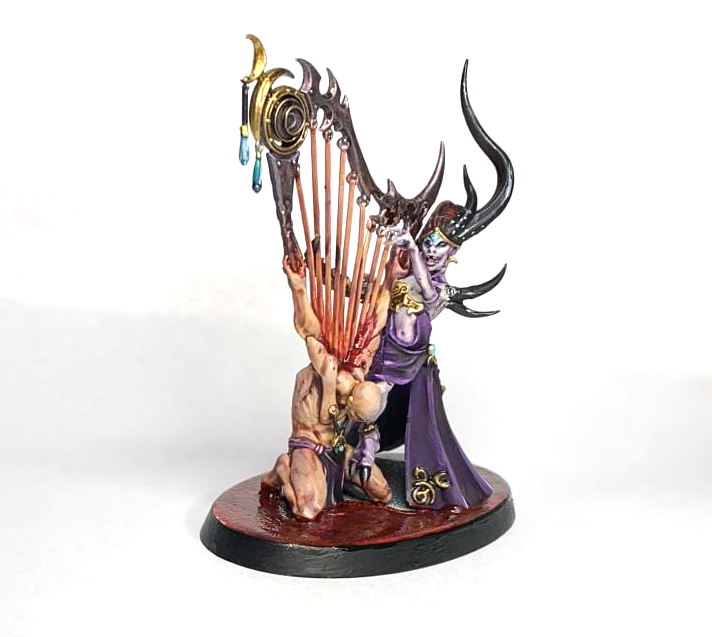
A while back I grabbed the Realm of Chaos: Wrath and Rapture box because 1) I really wanted to get my hands on the Infernal Enrapturess model and 2) I’d convinced myself I may someday want to paint the rest. After painting the model, I replicated the scheme on the Daemonettes so that I could at least say that I painted more than 1 model out of the box before buying the next big box item.
The Daemonettes were done pretty quickly and ended up being the test scheme for some Age of Sigmar Idoneth Deepkin Reavers. As with most things I’ve painted recently they use a combination of shades and regular paints. These also happened to be the first things I painted in a while that didn’t use any Contrast paint.

Step 0: Primer
Prime everything in Citadel Wraithbone (I used the rattle can, but (air)brushing it on would probably be fine too).
Step 1: Base coats
- Paint the leather parts in Citadel Incubi Darkness
- Paint the cloth parts in Citadel Thousand Sons Blue
- Paint the hair in Citadel Emperors Children
- Paint the metal areas in VMA Steel (similar to Citadel Stormhost silver)
- Any other areas (tassels, banners etc…) use either the blue or pink.
Step 2: Washes/Shades
- Thin down Citadel Druchii Violet with Citadel Lahmian Medium 1:4 (1 part shade to 4 parts medium), and add a drop or two of water too. Cover the Wraithbone primer (which should just be the skin at this point) and the recesses of the silver areas. I saved some of this mixture in an empty pot for other projects, much like my Nurgle flesh wash.
- While the skin is wet. Wash in neat Citadel Carroberg Crimson over the claws to give a cheap gradient effect. I repeat this a couple of times to darken the claws.
- Wash the hair with neat Citadel Druchii Violet
- After the skin is dry. Heavily wash the cloth and leather in neat Citadel Drakenhoff Nightshade. For the cloth be extra careful on the pooling and drag the wash into the folds. Also I did a dot of it in the eye sockets and mouths.
Step 3: Highlights
- Layer Citadel Thousand Sons Blue and Citadel Baharroth Blue over the blue parts, with a final line of Citadel Blue Horror at select places (most raised edge of creases etc…). Use the same colours on the leather / incubi areas but skip the Blue Horror stage.
- Layer Citadel Emperors Children over the hair with a few strands painted in Citadel Fulgrim Pink
- Thin down Citadel Wraithbone and add Citadel Lahmian medium so you have a usable translucent beige. Apply this on the flat parts of the skin e.g. the tops of arms, shoulders, cheeks, foreheads etc…
- Highlight metals with VMA Silver.
Bonus: Blood-Soaked bases
If you’ve seen the HTBE: Slime bases I did a while back, this is a variation of that.
- Paint the base white/Wraithbone. Cover the base in Citadel Blood Angels Red Contrast (I lied about not using it, at least on the bases). While the paint is wet, bleed in some Citadel Troll Slayer Orange and stir it in places to give some variation to the red.
- Once it’s dry shade over the base with Citadel Carroberg Crimson.
- Paint a very few thin lines of Citadel Evil Sunz Scarlett and Citadel Troll Slayer Orange wherever the blood comes in to contact with something on the base to give the illusion that it’s less deep at that point. (e.g. rocks, or the model’s feet).
- Gloss the whole thing in Citadel ‘Ard Coat.
Fin!.
Have any questions or feedback? Drop us a note in the comments below or email us at contact@goonhammer.com.
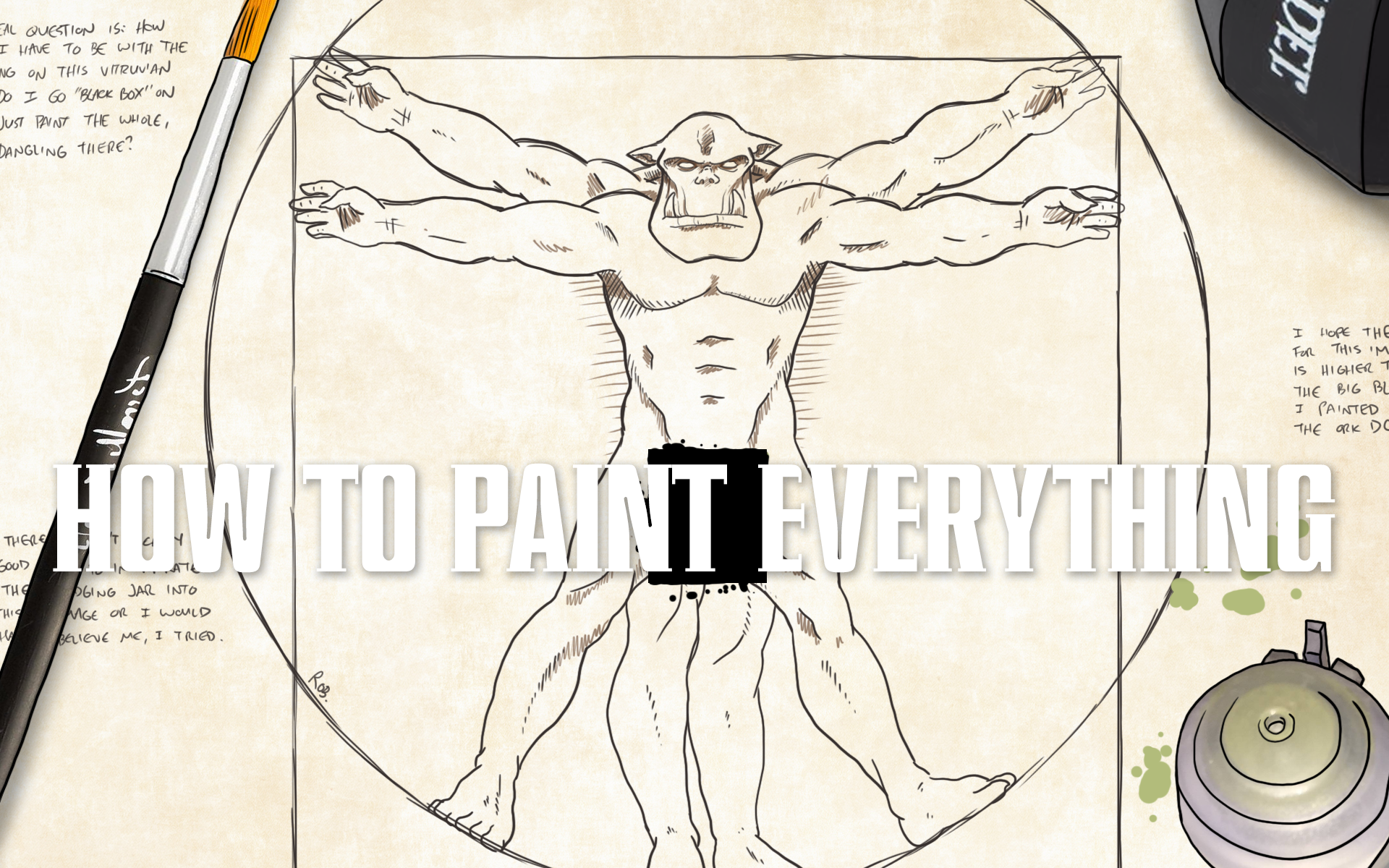


You must be logged in to post a comment.